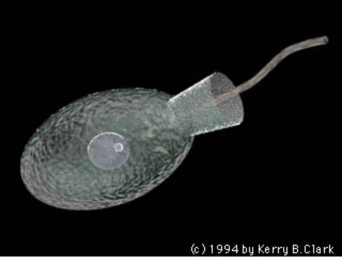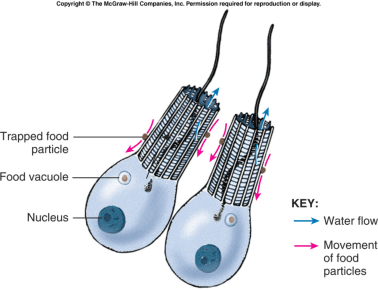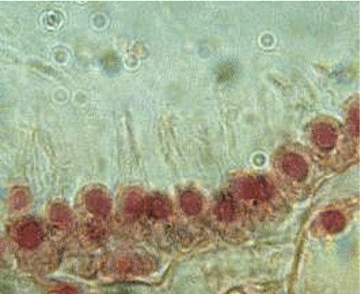
Evolution of the eukaryotic cell was followed by diversification into many lineages including, modern protozoans, plants, fungi, and animals. Go to http://tolweb.org/Eukaryotes/3 and examine the relationships tree found there. Answer question one.
Multicellular animals are called metazoans.
Many biologists feel that because of their similarity to certain cells found in sponges that Choanoflagellates, a group of protists that can be solitary or colonial, are the most likely group to have given rise to metazoans. They are characterized by possession of a flagella that is surrounded by a collar.
. 
Choanoflagellates resemble sponge feeding cells (choanocytes).


Scientists are studying colony formation and cell-to-cell communication in choanoflagellates in search of clues to the evolution of multicellularity.
Visit this website http://www.biology.ualberta.ca/courses.hp/zool250/animations/Choanoflagellate.swf Answer question 2.
Porifera (phylum level crown clade)
Molecular evidence suggests they do share a common ancestor with other animals. Molecular rRNA evidence suggests a common ancestor for choanoflagellates and metazoans. Sponges and Eumetazoa are sister groups with Porifera splitting off before Cnidaria. This also indicates that the Kingdom Animalia is monophyletic. Sponges appear in the fossil record before the Cambrian.
Basic characteristics
To learn about basic characteristics view the film below and then examine the diagrams of the different cell types found in sponges.
Porifera, are multicellular heterotrophs.
They are asymmetrical.
They lack true tissues and organs.
The general body plan consists of "more or less" recognizable cell types surrounding a spongocoel or internal cavity.
The simplest body wall is approximately two cell layers thick with a gel like substance called the mesenchyme or mesohyl in-between.
The body wall is perforated by many pores and channels through which water enters the animal, passing into the spongocoel, and exiting it through a large opening, the osculum. Mesenchyme, also know as mesohyl in sponges, is a gelatinous matrix that contains skeletal elements and archaeocytes or amebocytes.
Cell types
Pinacocytes are thin, flat, epithelial-type cells that cover the exterior and some interior surfaces of most sponge. As such, they form a collection of similar cells with similar function and probably the only cells that come close to forming a "tissue" (the pinacoderm) in sponges. However, they are not found in all sponges.
Other cell types secrete spicules (sclerocytes), spongin (spongocytes), & collagen (collenocytes).
Choanocytes, flagellated collar cells, generate a water current through the sponge and ingest suspended food.
Sponges are suspension feeders.
Water flows in through incurrent pores called dermal ostia. It flows past the choanocytes where food particles are collected on the choanocyte collar. The choanocytes pass food particles to archaeocyte (or amebocyte) cells for digestion. Digestion occurs entirely within cells, there is no gut.
Most pump a volume of water equal to their body volume, every five seconds. Sponges can slow or stop water flow to avoid taking in silt. They can control rate of water flow via a variety of methods:
_Contracting or relaxing cells which controls osculum diameter.
_Closing ostia if have more than one.
_Adjusting flagellar beat of collar bodies.
Double click on the movie below to learn more about sponge structure and water flow before answering question 3.
Answer question 3.
Body design (arrangement of cells important in water flow) varies, and the most complex body design is observed in large sponges.
There are three common body designs.
Asconoid – the simplest canal system.
Choanocytes line the spongocoel. Water enters through the ostia and exit through the large osculum. Usually tube shaped,with size essentially limited by body diameter. Found only in the class Calcarea.
Syconoid – tubular body and singular osculum like asconoids. Walls are thicker and so in theory allow for greater size than an asconoid grade of construction.
The walls of the sponge are folded to form choanocyte lined canals. This allows for increased area for feeding. All belong to the clade (old class level) Calcarea.
Leuconoids – most complex, permits an increase in sponge size.
Choanocytes line the walls of small chambers where they can filter all the water that flows through. Spongocoel is very reduced. Water flow is very directed. This is the type of canal system found in most sponges. This shape allows sponges to maintain water flow even after choanocytes have been poisoned.
Classification however is based on characteristics of skeleton structure.
The skeletal framework of a sponge may be fibrous or rigid.
The fibrous part comes from collagen fibrils in the intercellular matrix (Spongin).
Rigid skeletons consist of needlelike spicules (Calcareous or Siliceous).
Calcareous sponges (Clade or Class Calcarea) have spicules composed of calcium carbonate.
They are small, usually vase shaped and asconoid, syconoid, or leuconoid in structure.
Glass sponges (Clade or Class Hexactinellida) are mostly deep sea forms.
Spicules are six-rayed and made of silica. Hexactinellids lack a pinacoderm or gelatinous mesohyll. They have syncytial tissue, or tissue in which a number of cells have fused. There is a layer made up of a fusion of archaeocyte cell extensions or pseudopodia. This layer is know as the trabecular reticulum and forms the collar chambers opening to the spongocoel.
Chambers appear to correspond to both syconoid and leuconoid types.
Clade (Class) Demospongiae contains most of the sponge species.
Spicules are siliceous, but not six-rayed.
Spicules may be bound together by spongin, or spongin may be absent.
All are leuconoid, most are marine.
One Demosponge family of sponges, the Cladorhizidae, are carnivorous. They capture small crustaceans with filaments which stick to their shells like Velcro. Their cells then migrate around the prisoner and digest it.
Answer question 4.
Reproduction
Sperm production involves the choanocytes. In some species, sperm enter a different sponge body where they are captured and transferred to cells, which then travel through the tissue to an embedded egg.
Egg formation involves the amebocytes.
Eggs can be maintained in body cavity and sperm brought to them as diagrammed above or sperm and eggs can be shed into environment when the stimulus is right.
Sponges have remarkable regeneration capabilities.
Regeneration following fragmentation is a form of asexual reproduction.
External buds can break off to form new sponges. Internal buds (gemmules) in freshwater sponges can remain dormant in times of drought. Answer question 5.
Sponges discourage predation by producing potent toxins, which we may use some day as anti-fungals or in the treatment of cancer. Some animals, however, are spongivores such as nudibranchs, fish and turtles. Hawksbill turtle feces can consist by weight of 95% siliceous spicules. Some sponges release chemicals that kill competing sessile organisms, such as corals.
Phylogeny
Visit this website to confirm the following: http://www.ucmp.berkeley.edu/porifera/poriferafr.html
Sponges are an old animal group, perhaps the oldest animal group with living representatives.
Sponges are an offshoot (very different from most animal and so probably do not resemble the most recent common ancestor of most animals).
In the past, sponges were major contributors to reef formation.
Glass sponges are the oldest branch. http://www.ucmp.berkeley.edu/porifera/hexactinellida.html Answer question 6.
A sponge relative?
Placozoa (phylum level clade)
There is probably only one species, Trichoplax adhaerens, in the clade. Placozoans resemble giant amoebas. Although placozoans have been known for about 100 years their biology is poorly known. Link for biology and pictures
Some morphologists consider that placozoans are diploblastic or consists of two layers. There is a ventral layer consisting of monociliated cells and non ciliated gland cells. The dorsal layer consists mainly of flagellated epithelial or flat tightly jointed cells that form a "cover." In between is a fibrous syncytium that can contract.
Placozoans move over food, secrete digestive enzymes and absorb nutrients released. They can move in two ways, by using their cilia and a more gliding or amoeboid type of motion involving changes in body shape.
For the most part they are considered a sister group to s (A. most common or B.), although some molecular data suggests may have appeared later (C.). Answer question 7.